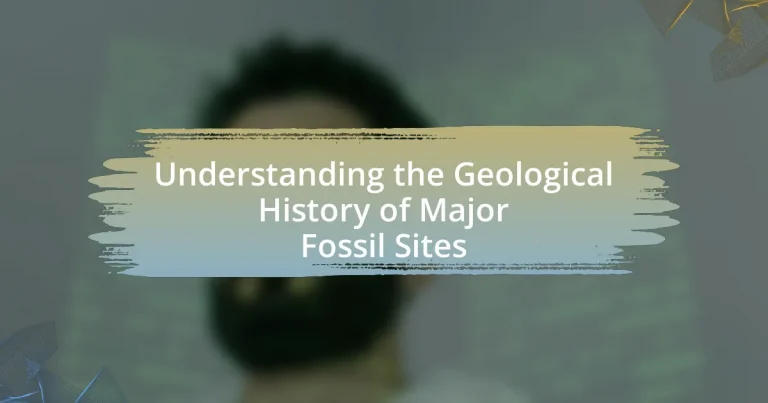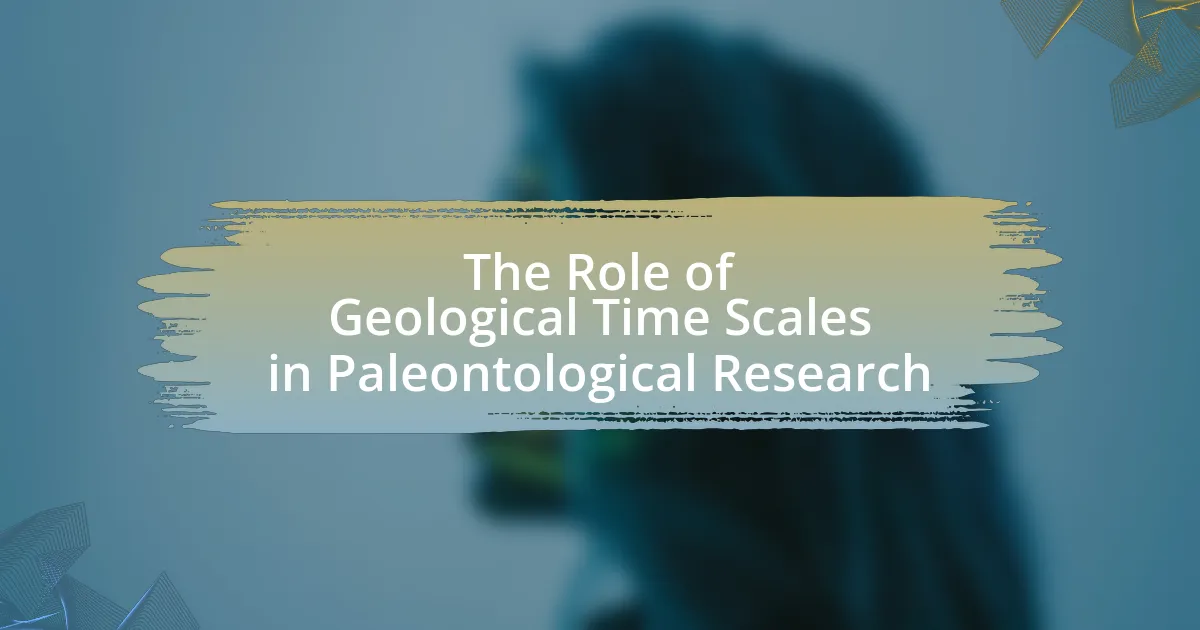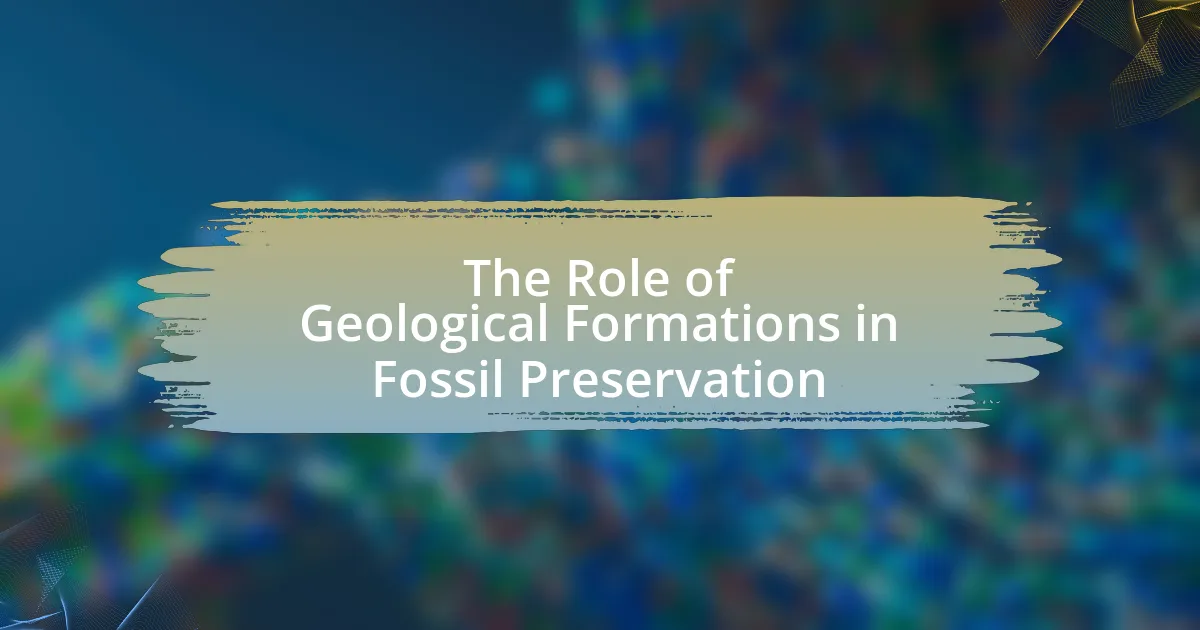The article focuses on understanding the geological history of major fossil sites, highlighting how geological processes contribute to fossil formation and preservation. It examines significant fossil sites such as the Burgess Shale and La Brea Tar Pits, detailing the unique geological characteristics that influence the types of fossils found there. Key topics include the role of sedimentary environments, stratigraphy, and radiometric dating in paleontological research, as well as the challenges researchers face in studying these sites. The article emphasizes the importance of geological context in interpreting fossil records and understanding past ecosystems.
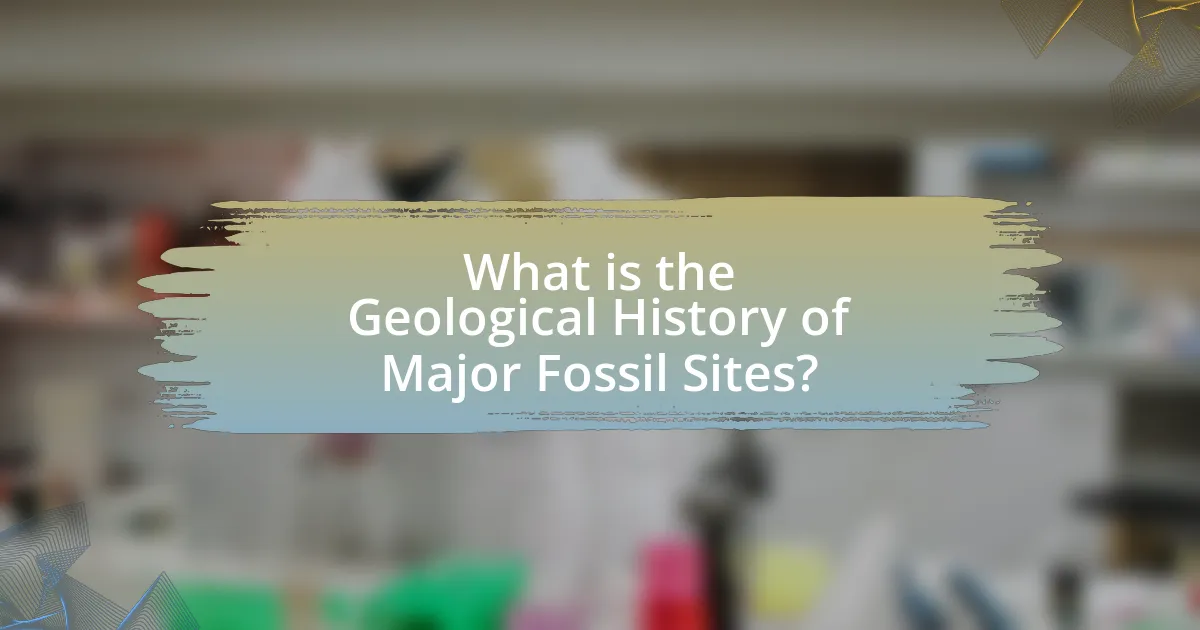
What is the Geological History of Major Fossil Sites?
The geological history of major fossil sites involves the processes and events that led to the formation and preservation of fossils in specific locations. For instance, the Burgess Shale in Canada, dating back to the Cambrian period approximately 508 million years ago, showcases a unique assemblage of soft-bodied organisms preserved in fine-grained sedimentary rock, providing insights into early marine life. Similarly, the La Brea Tar Pits in Los Angeles, formed during the last Ice Age, contain well-preserved remains of Pleistocene mammals trapped in natural asphalt, offering a glimpse into the fauna of that era. These sites illustrate how geological conditions, such as sedimentation, volcanic activity, and climate changes, contribute to fossilization and the subsequent discovery of significant paleontological records.
How do geological processes contribute to fossil formation?
Geological processes contribute to fossil formation primarily through sedimentation, which buries organic remains under layers of sediment. This burial protects the remains from decay and scavenging, allowing for the conditions necessary for fossilization to occur. Over time, pressure and mineral-rich water permeate the sediments, leading to the replacement of organic material with minerals, a process known as permineralization. Additionally, geological events such as volcanic eruptions or tectonic shifts can expose fossils by eroding overlying layers, making them accessible for study. Fossilization is further influenced by the environment, such as the presence of water, which aids in the preservation of remains.
What types of geological processes are involved in fossilization?
Fossilization involves several geological processes, primarily including burial, mineralization, and lithification. Burial occurs when organic remains are covered by sediment, protecting them from decay and physical disturbance. Mineralization follows, where minerals from groundwater infiltrate the organic material, replacing it and forming a fossil. Lithification is the process where sediments compact and cement together over time, solidifying the fossil within rock layers. These processes are essential for preserving the biological information contained in fossils, allowing scientists to study past life forms and their environments.
How do sedimentary environments affect fossil preservation?
Sedimentary environments significantly influence fossil preservation by determining the conditions under which organic remains are buried and mineralized. For instance, environments such as river deltas, lakes, and ocean floors provide fine sediments that can quickly cover and protect remains from decay and scavenging. In contrast, environments with high energy, like beaches or river rapids, may erode or displace remains before they can be buried. Research indicates that low-oxygen conditions, often found in deep marine sediments, enhance preservation by slowing decomposition and promoting the formation of fossils. Thus, the characteristics of sedimentary environments, including sediment type, energy levels, and oxygen availability, directly impact the likelihood and quality of fossil preservation.
Why is understanding geological history important for paleontology?
Understanding geological history is crucial for paleontology because it provides the context for the distribution and preservation of fossils. Geological history reveals the environmental conditions, climate changes, and biological evolution that have influenced the formation of fossil sites. For instance, sedimentary rock layers indicate the age and type of organisms that existed at different times, allowing paleontologists to reconstruct ancient ecosystems accurately. This understanding is supported by the principle of stratigraphy, which shows that fossils found in specific layers correspond to particular geological periods, thus enabling scientists to date and interpret the significance of fossil finds effectively.
How does geological context influence fossil interpretation?
Geological context significantly influences fossil interpretation by providing essential information about the environment in which the organisms lived and died. The sedimentary layers, mineral composition, and fossil associations within a geological formation help paleontologists reconstruct past ecosystems, climate conditions, and biological interactions. For instance, fossils found in marine sedimentary rocks indicate that the organisms lived in a marine environment, while those in fluvial deposits suggest a riverine habitat. Additionally, the dating of rock layers through radiometric methods allows scientists to establish a timeline for the fossils, which is crucial for understanding evolutionary processes. This contextual information is validated by numerous studies, such as those conducted by the Geological Society of America, which emphasize the importance of stratigraphy and sedimentology in paleontological research.
What role does stratigraphy play in studying fossil sites?
Stratigraphy plays a crucial role in studying fossil sites by providing a framework for understanding the chronological sequence of geological layers and the fossils contained within them. This discipline allows paleontologists to date fossils accurately and to interpret the environmental conditions at the time of deposition. For instance, the Law of Superposition states that in undisturbed strata, older layers are found beneath younger ones, enabling researchers to establish a timeline of biological evolution and extinction events. Additionally, stratigraphic correlation helps in identifying similar layers across different locations, which can reveal broader patterns in Earth’s history, such as mass extinctions or climate changes.

What are some major fossil sites around the world?
Some major fossil sites around the world include the Burgess Shale in Canada, the La Brea Tar Pits in the United States, and the Solnhofen Limestone in Germany. The Burgess Shale, dating back to the Cambrian period, is renowned for its exceptional preservation of soft-bodied organisms, providing insights into early marine life. The La Brea Tar Pits, active for thousands of years, have yielded a wealth of Ice Age fossils, including mammoths and saber-toothed cats, showcasing the diversity of prehistoric fauna. The Solnhofen Limestone, famous for its well-preserved Archaeopteryx fossils, offers critical evidence of the transition between dinosaurs and birds during the Late Jurassic period. These sites are significant for understanding the evolution and diversity of life on Earth.
How do different fossil sites vary in their geological characteristics?
Different fossil sites exhibit significant variation in their geological characteristics, influenced by factors such as sediment type, age, and environmental conditions at the time of deposition. For instance, the La Brea Tar Pits in California are characterized by asphaltic deposits that preserve a unique assemblage of Pleistocene fossils, while the Burgess Shale in Canada features fine-grained sedimentary rocks that provide exceptional preservation of soft-bodied organisms from the Cambrian period. These differences arise from the specific geological processes and environments, such as marine versus terrestrial settings, that shaped each site, leading to distinct fossil assemblages and preservation conditions.
What unique features define the La Brea Tar Pits?
The La Brea Tar Pits are uniquely defined by their natural asphalt seeps, which trap and preserve a diverse array of prehistoric fossils. These tar pits have yielded over 3.5 million fossils, including those of mammoths, saber-toothed cats, and dire wolves, providing significant insights into the Pleistocene epoch. The preservation of these fossils is attributed to the anaerobic conditions created by the tar, which prevents decay and allows for the study of ancient ecosystems. Additionally, the site is notable for its ongoing excavation and research, making it a vital location for paleontological studies.
How does the Burgess Shale contribute to our understanding of early life?
The Burgess Shale significantly enhances our understanding of early life by providing a well-preserved snapshot of a diverse array of Cambrian organisms. This fossil site, located in Canada, contains over 150,000 specimens representing more than 100 different species, many of which exhibit complex body structures and behaviors not seen in later periods. The exceptional preservation of soft-bodied organisms in the Burgess Shale allows scientists to study the early evolution of multicellular life, revealing insights into the origins of major animal groups. Research published in “Nature” by Conway Morris and others highlights that the Burgess Shale showcases the rapid diversification of life during the Cambrian Explosion, illustrating the evolutionary pathways that led to modern animal phyla.
What types of fossils are commonly found at these sites?
Commonly found fossils at major fossil sites include dinosaur bones, marine invertebrates, and plant remains. These fossils provide insights into the biodiversity and environmental conditions of past geological eras. For instance, sites like the Hell Creek Formation in Montana yield dinosaur fossils such as Tyrannosaurus rex and Triceratops, while the Burgess Shale in Canada is renowned for its exceptional preservation of soft-bodied marine organisms, illustrating the Cambrian explosion of life.
What are the most significant fossil types discovered in the Hell Creek Formation?
The most significant fossil types discovered in the Hell Creek Formation include dinosaur remains, particularly those of Tyrannosaurus rex and Triceratops, as well as various species of prehistoric mammals, reptiles, and plants. The Hell Creek Formation, dating to the late Cretaceous period, is renowned for its rich assemblage of fossils that provide insights into the ecosystem just before the mass extinction event. Notably, the presence of well-preserved dinosaur bones and teeth, along with fossilized flora such as ferns and cycads, underscores the diversity of life during that era.
How do marine fossil sites differ from terrestrial ones?
Marine fossil sites differ from terrestrial ones primarily in their sedimentary environments and the types of organisms preserved. Marine sites typically contain fossils of aquatic organisms such as fish, mollusks, and corals, which are often found in sedimentary rock layers formed by the accumulation of marine sediments. In contrast, terrestrial fossil sites predominantly feature land-dwelling organisms like dinosaurs, mammals, and plants, preserved in sedimentary rocks formed from terrestrial processes such as river deposits or volcanic ash. The conditions for fossilization also vary; marine environments often promote rapid burial and preservation due to sedimentation rates, while terrestrial environments may expose fossils to weathering and erosion.
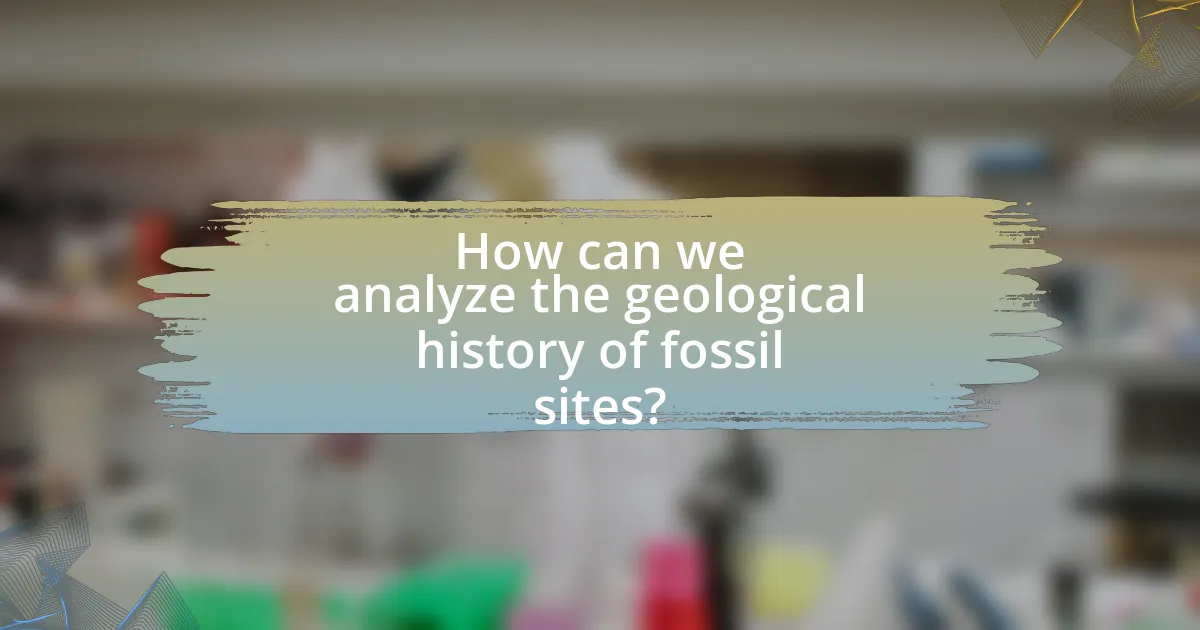
How can we analyze the geological history of fossil sites?
To analyze the geological history of fossil sites, researchers utilize stratigraphic analysis, radiometric dating, and sedimentological studies. Stratigraphic analysis involves examining the layers of rock and sediment to understand the chronological sequence of deposition, which provides insights into the environmental conditions at the time of fossil formation. Radiometric dating techniques, such as carbon dating or uranium-lead dating, allow scientists to determine the age of the rocks surrounding the fossils, establishing a timeline for when the organisms lived. Sedimentological studies focus on the characteristics of the sediments, including grain size and composition, which can indicate the depositional environment and help reconstruct past ecosystems. These methods collectively contribute to a comprehensive understanding of the geological history of fossil sites, supported by empirical data from various geological formations.
What methods are used to study the geological history of fossil sites?
Geologists use several methods to study the geological history of fossil sites, including stratigraphy, radiometric dating, and paleomagnetic analysis. Stratigraphy involves analyzing sedimentary layers to understand the sequence of geological events and the age of fossils within those layers. Radiometric dating, such as carbon dating, provides precise age estimates for fossils and surrounding materials by measuring the decay of radioactive isotopes. Paleomagnetic analysis examines the magnetic properties of rocks to determine historical changes in Earth’s magnetic field, which can correlate with specific geological periods. These methods collectively enhance the understanding of the temporal and environmental context of fossil sites.
How does radiometric dating help in understanding fossil ages?
Radiometric dating helps in understanding fossil ages by providing a method to determine the age of rocks and fossils through the decay of radioactive isotopes. This technique measures the ratio of parent isotopes to daughter isotopes in a sample, allowing scientists to calculate the time elapsed since the rock or fossil was formed. For example, uranium-lead dating can date rocks that are millions to billions of years old, which is crucial for placing fossils within the correct geological time frame. This method has been validated through cross-referencing with other dating techniques and the geological time scale, ensuring its reliability in establishing the ages of fossils and the history of life on Earth.
What role do paleomagnetic studies play in geological analysis?
Paleomagnetic studies play a crucial role in geological analysis by providing insights into the historical movements of tectonic plates and the Earth’s magnetic field. These studies involve measuring the magnetic properties of rocks, which can reveal the latitude at which they were formed and the orientation of the Earth’s magnetic field at that time. For instance, paleomagnetic data has been instrumental in reconstructing the positions of continents over geological time, helping to confirm theories such as continental drift and plate tectonics. This evidence is supported by findings from various geological formations, where paleomagnetic signatures align with known geological events, thus validating the role of paleomagnetism in understanding the geological history of major fossil sites.
What challenges do researchers face in studying fossil sites?
Researchers face several challenges in studying fossil sites, including geological instability, limited access, and preservation issues. Geological instability can lead to erosion or destruction of fossil beds, making it difficult to obtain reliable data. Limited access to remote or protected sites restricts the ability to conduct thorough investigations. Additionally, preservation issues arise when fossils are exposed to environmental factors that can degrade their quality, complicating analysis and interpretation. These challenges hinder the ability to accurately reconstruct the geological history and biological diversity of past ecosystems.
How do environmental changes impact fossil site preservation?
Environmental changes significantly impact fossil site preservation by altering the conditions necessary for fossilization and the stability of fossil-bearing strata. For instance, climate shifts can lead to erosion, sedimentation changes, and alterations in groundwater levels, which can expose fossils to destructive elements or bury them under new layers of sediment. Research indicates that increased rainfall can enhance erosion rates, while drought conditions may lead to desiccation and cracking of sedimentary layers, both of which threaten fossil integrity. Additionally, tectonic activity can uplift or subside fossil sites, further affecting their preservation potential.
What are the limitations of current fossil excavation techniques?
Current fossil excavation techniques face several limitations, including the potential for damage to fossils, the inability to access certain geological layers, and the reliance on manual labor, which can introduce human error. Fossil preservation is often compromised during excavation due to the use of heavy machinery or improper handling, leading to the loss of valuable information. Additionally, some fossil deposits are located in hard-to-reach areas, making it difficult to excavate without advanced technology. The manual nature of many excavation processes can result in inconsistent results, as different excavators may apply varying techniques and levels of care. These limitations hinder the comprehensive understanding of fossil sites and the geological history they represent.
What best practices should be followed when studying fossil sites?
When studying fossil sites, researchers should prioritize systematic excavation techniques to ensure the preservation of the geological context and the fossils themselves. Systematic excavation involves carefully removing sediment in layers, documenting the stratigraphy, and recording the precise location of each fossil. This method allows for a better understanding of the environmental conditions at the time of fossilization and aids in reconstructing the paleoecology of the site. Additionally, researchers should utilize proper tools and techniques, such as brushes and small hand tools, to minimize damage to delicate specimens. Accurate field notes and photographs should be taken to document the site conditions and fossil positions, which are crucial for later analysis. Following these best practices enhances the reliability of the findings and contributes to the broader understanding of geological history.
